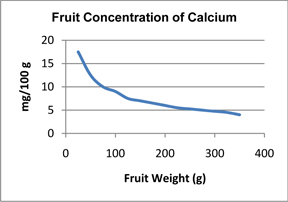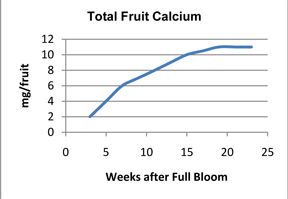Bitterpit control in apples
Low calcium levels are the source of bitterpit in apples.
Bitterpit is serious physiological disorder related to low calcium levels in the fruit (especially just under the peel). The major calcium effect in apple is the maintenance of membranes and cell wall structures, which, in turn, slows breakdown and maintains firmness of fruits. Bitterpit is the breakdown of the cells just under the peel where calcium levels are too low. Therefore, the focus for controlling bitterpit is on soil, leaf and ultimately fruit calcium. Some varieties (such as Cortland, Honeycrisp, Northern Spy, etc.) have a genetic susceptibility to Bitterpit. Bitterpit in other apple varieties is influenced by other factors, such as climate, orchard block characteristics and especially cropload/tree vigor. Soil calcium levels, soil pH, other nutrient levels, cropload balance, calcium sprays and postharvest calcium treatments all affect calcium levels in fruit. Increasing calcium levels in the fruit will reduce this disorder.
Figure 1. Apple fruit seasonal calcium concentration.

Figure 2. Seasonal total apple fruit calcium.

Fruitlets have high calcium levels in the spring (Figure 1) but as the fruit grow in size, fruit calcium concentration decreases. Fruit will accumulate calcium over the entire season (Figure 2), but environmental conditions can still cause bitterpit problems. Soil applied lime and gypsum will increase fruit calcium, but need to be applied annually and results will be slow to detect (2 to 3 years). Generally, spray applications of foliar calcium periodically improves control but might not cure the disorder. It is important to start foliar calcium sprays right after petal fall and continue applications until harvest. Frequent calcium applications are better than less frequent, high-rate applications. Some years on some varieties, weather can overwhelm even the best calcium program. Postharvest drenches are important to help stop this disorder from developing further in storage.
Methods to increase calcium
- Keep soil pH at the optimum range for apples, 6.5 to 7.0.
- Lime with high-cal lime where needed. Keep soil levels abundant.
- Keep B and Zn levels at optimum levels as deficiencies will increase Ca disorders.
- Keep Mg and K levels at optimum levels as excessive levels increase Ca disorders.
- Consider Gypsum application in the early spring to provide luxury Ca.
- Use tissue analysis to identify Ca needs. Leaf should be 1.3% to 2%. 1.6% or greater is usually required to minimize disorders.
- Excessive pruning, excessive N, excessive vigor, low fruit loads and droughty conditions will increase bitterpit.
- Try to achieve uniform moderate tree vigor with annual moderate croploads.
- Apply calcium sprays to trees every two weeks, starting a week after petal fall.
- Use 1 to 2#/100 of CaCl2 early season and for the last 2 sprays, 2 to 4#/100.
- A seasonal rate of 7 to 14# Ca is desired.
- Avoid temperatures above 80oF and especially when humidity is high.
- Maintain agitation in the tank when adding calcium.
- Watch out for compatibility with other products.
- Applications should be frequent and coverage complete. The calcium is taken in through the fruit skin and not the leaves.
- Calcium postharvest dips will put more calcium in an apple than a whole season of sprays.
- Apogee will help control vigor and may increase fruit Ca.
- Irrigation will reduce drought/Calcium stress.



 Print
Print Email
Email